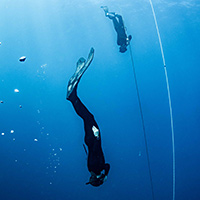A month ago the Madagascar Whale Shark Project’s first season came to an end. After completing all the end of season reports to funding bodies, I now can focus on data analysis and processing all the ID pictures! While we will be publishing an end of season report later on, my estimate for this year’s population size lies between 80 and 90 different individuals seen throughout the season.
The last two weeks, in particular, were shark-filled, with up to 20 ‘new’ sharks that had never been seen before seen within a week! While some individuals were seen only once, others such as our favorite shark Michel, were seen 15 times! Even his tagging data seems to indicate he likes hanging around in Nosy Be. I saw him again on my last day which was a great way to end the season…

Probably due to warmer sea surface temperature, Trichodesmium; a genus of cyanobacteria, slowly grew day after day to create widespread blooms, attracting tiny fish and shrimps that fed on the nitrogen-fixing nutrient. As a result it meant Omura whales, as well as whale sharks were regularly found within these dense patches, with the sharks floating vertically using a suction method to draw prey into their mouths, a behaviour called ‘vertical feeding’ and truly mesmerising to witness . Often we’d spot both species feeding at once, amongst fishing tunas and terns. More than once, I spotted two sharks feeding on the same patch, a surreal experience as they emerged one by one from the blue depths…

From the end of November onwards, day after day we were spoiled with a glassy sea, perfect conditions, no boats around and heaps of sharks. I took 20+ biopsies, aka skin samples that are taken from the shark’s skin and blubber using a harpoon-like pole. This technique doesn’t hurt the shark as they have really thick skin, and allows us to find out whether the sharks we sample are genetically related to each other. Biopsies also give us information about the shark’s diet in the previous weeks. and consequently how deep they might have gone to feed. Once a shark has been ‘biopsied’, the sample is kept refrigerated until we get back to the office, where it is processed into different samples and kept in the freezer. Getting a biopsy from a tourist boat required coordination within the team, in order to drop me right in front of the shark as fast as possible to be sure it was the same shark we just identified, and not bother the clients onboard, who were told to stay on the boat.

Aside from intense sharking, I had the chance to accompany Dr. Salvatore Cerchio for a day, the lead scientist behind the novel project studying Omura whales in Nosy Be, one of the most mysterious and elusive creatures that has never been studied in the wild. I also gave a small presentation at a local French school about the project, thanks to teacher Flora who organised it. Kids couldn’t contain their excitment when I showed them the timelapse videos illustrating the tracks of our tagged sharks.
A big thank to the Baleines Rand’eau team for all their help, and to all those that have been involved with this year’s season. We grew as a strong (dream) team throughout the season, with the tourism and science aspects nicely blending in together, and great science was done! Stay posted for more updates.


 janvier 13, 2017
janvier 13, 2017